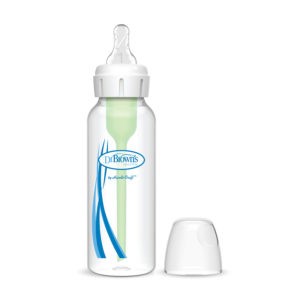There is so much to prepare as you anticipate the arrival of a new baby. Items to buy, clothes to wash, and parenting books to read. For many families with newborns, one of the biggest learning curves is figuring out their infants’ feeding needs and how best to meet them.
Whether breastfeeding, pumping and giving expressed breast milk, formula feeding, or a combination of any of these methods, so much goes into feeding such a tiny human. Many parents feel overwhelmed as they try to decide how much milk their baby needs, when they need to feed them, and how to identify if their baby is getting enough. As a pediatrician and parent, I will cover all of these points and more—and, hopefully, help ease some of that stress as you get into the rhythm of feeding your newborn during their first months of life!
Decide Your Feeding Plan
Before your baby’s arrival, it’s helpful to have an idea of which method of feeding you’d like to use. As mentioned above, there are many options worth exploring to see what best fits your needs. This is a personal choice; there is no right or wrong decision. There are pros and cons to each method, but the great news is babies can grow and thrive with both breast milk and/or formula. I recommend that parents keep an open mind, because depending on the needs of you or your baby, that initial feeding goal might need to be adjusted.
Hunger Cues and Feeding Frequency
Newborn stomachs start tiny—about the size of a marble at birth. By day ten of life, those tiny tummies grow to the size of a golf ball. Therefore, the quantity they take in will drastically change within the first month. You’ll want to follow your baby’s lead on how much to feed and how often. Unfortunately for us adults, newborns won’t say, “Hey! I’m getting hungry now!” Instead, they will likely give you behavioral cues that it’s time to feed. Early signs of hunger include licking or smacking lips, sticking out their tongue, or rooting (moving their mouth) towards a breast, bottle, or your finger. As they get hungrier, they may begin pulling their hands up toward their mouth and squirming. Late signs of hunger include fussing and crying.
Ideally, you want to start the feed before your baby starts crying. Once an infant is over-hungry, they may have a harder time latching or calming down to feed. Remember, not all fussing or crying is due to hunger. If you feed your baby and they are fussing within an hour or two of their last feeding, I recommend parents first try to calm them with a swaddle, pacifier, or other soothing technique. If they persist in fussing and are still showing hunger cues, you can offer another feed. Attempting to soothe them before feeding helps ensure their fussing is actually from true hunger rather than boredom, overstimulation, or just a need to be soothed.
Newborns will likely feed every two to three hours for the first few weeks of life. It’s common that they also go through periods of more frequent eating as they grow (more to come on cluster feeding).
Weight Gain and Waking to Feed
It’s normal for newborns to lose up to 10 percent of their birth weight initially. They usually regain this lost weight by two weeks of age. Until they meet their birth weight, it’s important to wake them up every three hours to offer a feed (timing this from the beginning of the last feed). Once back to birth weight, you typically no longer need to wake them up to feed at night and can allow them to lead the way. During the day, watch their cues, which will slowly stretch to an every-two-to-three-hour routine.
What About Cluster Feeding?
In the first month (and even beyond), you may experience cluster-feeding, where a baby feeds and then is hungry again quickly. This is common in all babies, no matter their feeding method. For breastfed babies, this is a natural way to increase a feeding parent’s breast milk supply during a growth spurt, and typically lasts three to five days. Formula-fed babies also experience this as they go through growth spurts. If your baby isn’t making wet diapers or doesn’t seem to be gaining weight despite this constant feeding, let your baby’s clinician know. Otherwise, take heart in knowing these cluster phases will pass.
How to Know They’re Getting Enough
It can be hard to know if your baby is getting “enough” during feedings, especially if feeding at the breast. Signs that a baby is full after a feed (whether bottle or breast) include seeming relaxed and content with their arms more open than clenched. Wet diapers are also important to monitor. Babies should typically have one wet diaper by day one of life, two by day two of life, three on day three of life, and usually five or more by day five of life. Stools start as black and tarry, but should transition to yellowish stools by day seven.
Typically, in the first weeks of life, a pediatrician will monitor the infant’s weight and ensure they are following their growth course. Some babies are slow to gain weight, but parents shouldn’t lose hope. If you’re breastfeeding, your pediatrician or lactation consultant will guide you if supplementation or pumping is necessary as your supply builds. It’s worth following up with your pediatrician if your infant is having fewer wet diapers than expected, their stool has not transitioned to yellow stool by one week, or if you have any concerns for weight loss or poor weight gain.
How Much is Too Much?
With frequent feeds, many parents get worried about “overfeeding” a baby. That is why it’s important to watch for hunger cues and fullness cues. Remember, not all crying is hunger; so, watch for those hunger cues to ensure responsive feeding.
In the first week of life, your baby is likely ingesting 1-2 ounces per feed if measured. As they approach a month, you may see this increase to 3-4 ounces per feed. Some babies can go a little higher than this.
If your baby finishes their bottle and still gives hunger cues, offer another ounce. If breastfeeding, and they finish feeding on one breast and still seem hungry, offer the other side.
If your baby is spitting up, consider burping mid-way through a feed, or slow down the pace of the feeding with a bottle. The Dr. Brown’s Natural Flow ® Anti-Colic Options+™ baby bottles are a great option for bottles that offer slow-flow feeding when needed. Make sure to find a nipple flow level that works for your baby.
If you’re watching hunger cues, there is technically no maximum amount of breast milk or formula an infant can ingest. But if you notice more spitting-up after increasing their feeds, it may be worth re-evaluating their hunger cues, decreasing feeding amounts and offering smaller feeds more frequently. For any spit-up concerns, especially if they seem bothered by their spit-up (for example: arching, or crying after feeds), make sure to speak to their clinician.
Above all else, remember that there is no user manual for your child. So, it’s important to learn from experience. Follow their cues, starting in the first month of your baby’s life.
About the author:
Dr. Mona Amin, Pediatrician.

Dr. Mona Amin is a Board Certified General Pediatrician, Parenting expert, and mother.
She has been featured on Parents.com, Romper, CondeNast Traveler, VeryWell Family, NBC News, and was named one of Insider’s Top Pediatricians to follow on social media for 2020. She works in private practice and her passions include: early childhood development, focusing on the impact of healthy sleep, a healthy relationship with food, and healthy coping skills in the first five years of a child’s life.
On her Instagram account (@pedsdoctalk), her podcast (The Pedsdoctalk Podcast), and YouTube channel (Pedsdoctalk TV), she shares educational information on parent’s most common concerns (i.e. fevers, rashes, viruses, behavioral issues, etc.) including current events. Her brand, Pedsdoctalk, has a goal to provide relatable and easy-to-digest education for the modern parent regarding the health and wellness of their child.

